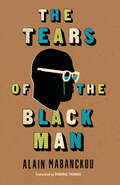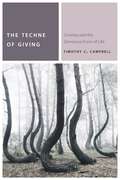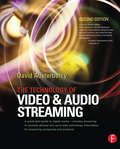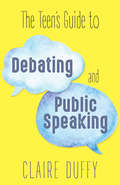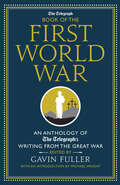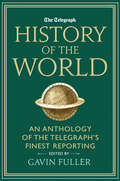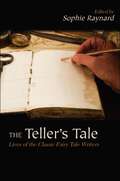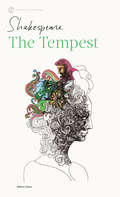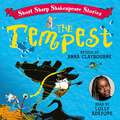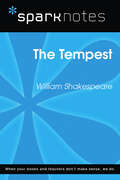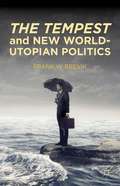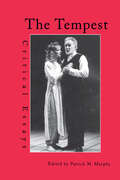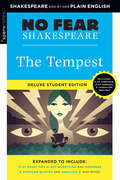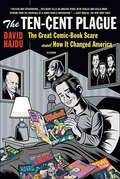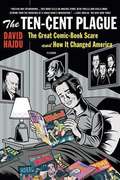- Table View
- List View
The Tears of the Black Man (Global African Voices Ser.)
by Alain Mabanckou&“[An] intellectually dense collection . . . Mabanckou&’s challenging perspective on African identity today is as enlightening as it is provocative.&” —Publishers Weekly In The Tears of the Black Man, award-winning author Alain Mabanckou explores what it means to be black in the world today. Mabanckou confronts the long and entangled history of Africa, France, and the United States as it has been shaped by slavery, colonialism, and their legacy today. Without ignoring the injustices and prejudice still facing blacks, he distances himself from resentment and victimhood, arguing that focusing too intenselyon the crimes of the past is limiting. Instead, it is time to ask: Now what? Embracing the challenges faced by ethnic minority communities today, The Tears of the Black Man looks to the future, choosing to believe that the history of Africa has yet to be written and seeking a path toward affirmation and reconciliation.Praise for Alain Mabanckou and his works &“Mabanckou counts as one of the most successful voices of young African literature.&” —Internationales Literaturfestival Berlin &“Africa&’s Samuel Beckett . . . one of the continent&’s greatest living writers.&” —The Guardian &“One of the most compelling books you&’ll read in any language this year.&” —Rolling Stone
The Tears of the Black Man (Global African Voices)
by Dominic Thomas Alain MabanckouIn The Tears of the Black Man, award-winning author Alain Mabanckou explores what it means to be black in the world today. Mabanckou confronts the long and entangled history of Africa, France, and the United States as it has been shaped by slavery, colonialism, and their legacy today. Without ignoring the injustices and prejudice still facing blacks, he distances himself from resentment and victimhood, arguing that focusing too intensely on the crimes of the past is limiting. Instead, it is time to ask: Now what? Embracing the challenges faced by ethnic minority communities today, The Tears of the Black Man looks to the future, choosing to believe that the history of Africa has yet to be written and seeking a path toward affirmation and reconciliation.
The Techne of Giving: Cinema and the Generous Form of Life (Commonalities)
by Timothy C. CampbellOver the last five years, corporations and individuals have given more money, more often, to charitable organizations than ever before. What could possibly be the downside to inhabiting a golden age of gift-giving? That question lies at the heart of Timothy Campbell’s account of contemporary giving and its social forms. In a milieu where gift-giving dominates, nearly everything given and received becomes the subject of a calculus—gifts from God, from benefactors, from those who have. Is there another way to conceive of generosity? What would giving and receiving without gifts look like?A lucid and imaginative intervention in both European philosophy and film theory, The Techne of Giving investigates how we hold the objects of daily life—indeed, how we hold ourselves—in relation to neoliberal forms of gift-giving. Even as instrumentalism permeates giving, Campbell articulates a resistant techne locatable in forms of generosity that fail to coincide with biopower’s assertion that the only gifts that count are those given and received. Moving between visual studies, Winnicottian psychoanalysis, Foucauldian biopower, and apparatus theory, Campbell makes a case for how to give and receive without giving gifts. In the conversation between political philosophy and classic Italian films by Visconti, Rossellini, and Antonioni, the potential emerges of a generous form of life that can cross between the visible and invisible, the fated and the free.
The Technology of Video and Audio Streaming
by David Austerberry* Learn the end-to-end process, starting with capture from a video or audio source through to the consumer's media player* A quick-start quide to streaming media technologies* How to monetize content and protect revenue with digital rights managementFor broadcasters, web developers, project managers implementing streaming media systems, David Austerberry shows how to deploy the technology on your site, from video and audio capture through to the consumer's media player. The book first deals with Internet basics and gives a thorough coverage of telecommunications networks and the last mile to the home. Video and audio formats are covered, as well as compression standards including Windows Media and MPEG-4. The book then guides you through the streaming process, showing in-depth how to encode audio and video. The deployment of media servers, live webcasting and how the stream is displayed by the consumer's media player are also covered.A final section on associated technologies illustrates how you can protect your revenue sources with digital rights management, looks at content delivery networks and provides examples of successful streaming applications.The supporting website, www.davidausterberry.com/streaming.html, offers updated links to sources of information, manufacturers and suppliers.David Austerberry is co-owner of the new media communications consultancy, Informed Sauce. He has worked with streaming media since the late nineties. Before that, he has been product manager for a number of broadcast equipment manufacturers, and formerly had many years with a leading broadcaster.
The Technology of the Novel: Writing and Narrative in British Fiction
by Tony E. Jackson2009 Outstanding Academic Title, ChoiceThe connection between speech and writing in human language has been a matter of philosophical debate since antiquity. By plumbing the depths of this complex relationship, Tony E. Jackson explains how the technology of alphabetic writing has determined the nature of the modern novel.Jackson’s analysis begins with the universal human act of oral storytelling. While telling stories is fundamental to human experience, writing is not. Yet the novel, perhaps more than any other literary form, depends on writing. In fact, as Jackson shows quite clearly, it is writing rather than print that most shapes the forms and contents of the genre.Through striking new readings of works by Austen, Mary Shelley, Dickens, Forster, Woolf, Lessing, and McEwan, Jackson reveals how the phenomena of speech and storytelling interact with the technological characteristics of writing. He also explains how those interactions induced the generic changes in the novel from its eighteenth-century beginnings to postmodernism and beyond. His claims, grounded in a contemporary understanding of human cognitive capacities and constraints, offer a fresh interpretive approach to all written literature.An essential text in the study of the written word, The Technology of the Novel provides new insights into the evolving nature of one of the modern world's most popular narrative forms.
The Teen's Guide to Debating and Public Speaking
by Claire DuffyEverything students, parents, and teachers need to know about debating and public speaking. Welcome to the world of school debating and public speaking, the best training ground for developing self-esteem and learning to look critically at big issues. Speaking well builds confidence and opens up a world of opportunity, in education, leadership, careers, and community and political engagement. In an increasingly competitive world, being a convincing, passionate, and persuasive speaker is essential to standing out from the crowd. Claire Duffy not only demystifies the process but makes it fun. Learn all about the best ways to prepare for a debate or speech, the persuasive power of reason, the art of argument and rebuttal, and, when worse comes to worst, how to be gracious in defeat. Including practical tips from the pros and helpful step-by-step examples, this is the essential handbook for making every spoken word count.
The Telegraph Book of the First World War: An Anthology of the Telegraph's Writing from the Great War (Telegraph Bks.)
by Gavin Fuller and Michael WrightAn WWI archive of Great Britain’s Daily Telegraph news coverage reveals how the press influenced public perception of the Great War.One hundred years on, the First World War has not lost its power to clutch at the heart. But how much do we really know about the war that would shape the twentieth century? And, all the more poignantly, how much did people know at the time?Today, someone fires a shot on the other side of the world and we read about it online a few seconds later. In 1914, with storm clouds gathering over Europe, wireless telephony was in its infancy. So newspapers such as the Daily Telegraph were, for the British public, their only access to official news about the progress of the war.These reports, many of them eye-witness dispatches, written by correspondents of the Daily Telegraph, bring the WWI to life in an intriguing new way. At times, the effect is terrifying, as accounts of the Somme, Flanders and Gallipoli depict brave and glorious victories, and the distinction between truth and propaganda becomes alarmingly blurred. Some exude a sense of dramatic irony that is almost excruciating, as one catches glimpses of how little the ordinary British people were told during the war of the havoc that was being wrought in their name.Poignant, passionate and shot-through with moments of bleak humour, The Telegraph Book of the First World War is a full account of the war by some of the country’s most brilliant and colourful correspondents, whose reportage shaped the way that the war would be understood for generations to come.
The Telegraph History of the World: An Anthology of the Telegraph's Finest Reporting
by Gavin Fuller and Max DavidsonAn archive of Great Britain’s Daily Telegraph news coverage highlights the major historical events from the Victorian era through the twenty-first century.Celebrating 160 years of reporting, this is an anthology of the headlines that the Telegraph made. The paper sent Stanley to Africa and George Smith to discover the Babylonian story of Noah on ancient tablets. The twenty-two-year-old Churchill wrote from the North-West frontier at £5 a column, and Kipling from the front in the First World War. As well as showcasing the talents of many of these eminent correspondents, The Telegraph History of the World gives a fascinating picture of the way people lived and how news was reported. In 1932 when reporting on the German presidential elections the Telegraph’s headline read “Herr Hitler’s Hopes Dashed Forever.” Not all doom and gloom, the royal births and weddings as well as political scandals make for a diverse and interesting collection from late nineteenth century to the early twenty-first century.
The Teller's Tale: Lives of the Classic Fairy Tale Writers
by Sophie RaynardThis book offers new, often unexpected, but always intriguing portraits of the writers of classic fairy tales. For years these authors, who wrote from the sixteenth to the nineteenth centuries, have been either little known or known through skewed, frequently sentimentalized biographical information. Jacob and Wilhelm Grimm were cast as exemplars of national virtues; Hans Christian Andersen's life became—with his participation—a fairy tale in itself. Jeanne-Marie Leprince de Beaumont, the prim governess who wrote moral tales for girls, had a more colorful past than her readers would have imagined, and few people knew that nineteen-year-old Marie-Catherine d'Aulnoy conspired to kill her much-older husband. Important figures about whom little is known, such as Giovan Francesco Straparola and Giambattista Basile, are rendered more completely than ever before. Uncovering what was obscured for years and with newly discovered evidence, contributors to this fascinating and much-needed volume provide a historical context for Europe's fairy tales.
The Tempest
by Nick NewlinThe Tempest: The 30-Minute Shakespeare offers eight scenes from this rich comedy. Beginning with the magical storm and shipwreck, this adaptation includes the uproarious discovery of the monster Caliban and his plot to kill Prospero. Included are the heartfelt marriage vows between Ferdinand and Miranda, the disguised antics of fairy Ariel, and Prospero's poetic abjuration of his rough magic. The edition includes a preface by Nick Newlin containing helpful advice on how to put on a Shakespeare performance in a high school class with novice actors as well as an appendix with suggestions for the specific play and recommendations for further resources.
The Tempest
by William ShakespeareThis bewitching play, Shakespeare's final work, articulates a wealth of the playwright's mature reflections on life and contains some of his most familiar and oft-quoted lines. The story concerns Miranda, a lovely young maiden, and Prospero, her philosophical old magician father, who dwell on an enchanted island, alone except for their servants — Ariel, an invisible sprite, and Caliban, a monstrous witch's son. Into their idyllic but isolated lives comes a shipwrecked party that includes the enemies who usurped Prospero's dukedom years before, and set him and his daughter adrift on the ocean. Also among the castaways is a handsome prince, the first young man Miranda has ever seen. Comedy, romance, and reconciliation ensue, in a masterly drama that begins with a storm at sea and concludes in joyous harmony.
The Tempest
by William ShakespeareProspero, sorcerer and rightful Duke of Milan, along with his daughter Miranda, has lived on an island for many years since his position was usurped by his brother Antonio. <P><P>Then, as Antonio's ship passes near the island one day, Prospero conjures up a terrible storm...This play, combining elements of both tragedy and comedy, is believed by some to be the last Shakespeare wrote on his own, as well as one of his most fascinating works. The Signet edition also features an overview of Shakespeare's life and times, commentary by William Strachey, Montaigne, and others, and a stage and screen history, among other special content.
The Tempest (Baker Street Readers)
by William Shakespeare Helen Street Charly CheungA storm, a shipwreck, an enchanted island ...A violent storm shipwrecks the King of Naples and his noblemen on what appears to be an uninhabited island. What the king doesn’t know is that they have been brought here by powerful magic. Prospero, the mysterious ruler of the island, has a plan, but will he use his magic for good or bad against the castaways? His daughter, Miranda, has never seen another man except her father. What will she think of the stranger who stumbles into her life? Prospero’s monstrous servant, Caliban, sees a chance to overthrow his master. Will he succeed? Enchantment and treachery are everywhere on the island – which will prove the stronger? Baker Street Readers are retellings of literary classics in 64 pages, with illustrations. These books make classic stories available to intelligent young readers as a bridge to the full texts and to language students wanting access to other cultures.
The Tempest (Short, Sharp Shakespeare Stories #28)
by Anna ClaybourneBe not afeard; the isle is full of noises...A powerful storm, a dramatic shipwreck, an enchanted island, a sorcerer's daughter and a handsome prince... Listen on, through magic and mystery, to discover the spell-binding story at the heart of The Tempest, one of Shakespeare's best-loved plays.As well as the story, this audiobook contains information about the background to The Tempest, its major themes, language, and Shakespeare's life during the time he was writing the play. Magic, and its meaning in 16th century England, are also examined, to give some context in which the play was written.The Short, Sharp Shakespeare series consists of six books that retell Shakespeare's most famous plays in modern English. Fun sound effects and atmospheric music accompany each narration, making them a great introduction to "the Bard" for children.(P) 2023 Hodder & Stoughton Limited
The Tempest (SparkNotes Literature Guide Series)
by SparkNotesThe Tempest (SparkNotes Literature Guide) by William Shakespeare Making the reading experience fun! Created by Harvard students for students everywhere, SparkNotes is a new breed of study guide: smarter, better, faster. Geared to what today's students need to know, SparkNotes provides: *Chapter-by-chapter analysis *Explanations of key themes, motifs, and symbols *A review quiz and essay topicsLively and accessible, these guides are perfect for late-night studying and writing papers
The Tempest and New World-Utopian Politics
by Frank W. BrevikThis study on New World-utopian politics in The Tempest traces paradigm shifts in literary criticism over the past six decades that have all but reinscribed the text into a political document. This book challenges the view that the play has a dominant New World dimension and demonstrates through close textual readings how an unstable setting at the same time enables and effaces discursively over-invested New World interpretations. Almost no critical attention has been paid to the play's vacuum of power, and this work interprets pastoral, utopian, and 'American' tensions in light of the play's forever-ambiguous setting as well as through a 'presentist' post-1989 lens, an oft-neglected historical and political paradigm shift in Shakespeare criticism.
The Tempest: Critical Essays (Shakespeare Criticism #Vol. 21)
by Patrick M. MurphyThe Tempest: Critical Essays traces the history of Shakespeare's controversial late romance from its early reception (and adaptation) in the seventeenth and eighteenth centuries to the present. The volume reprints influential criticism, and it also offers eight originalessays which study The Tempest from a variety of contemporary perspectives, including cultural materialism, feminism, deconstruction, performance theory, and postcolonial studies. Unlike recent anthologies about The Tempest which reprint contemporary articles along with a few new essays, this volume contains a mixture of old and new materials pertaining to the play's use in the theater and in literary history.
The Tempest: Modern English Version Side-by-Side With Full Original Text (Shakespeare Made Easy Series)
by William Shakespeare Alan DurbandThis wonderful presentation of Shakespeare's The Tempest features the play's original lines on each left-hand page, and a modern, easy-to-understand "translation" on the facing right-hand page. This invaluable teaching-study guide also includes: Helpful background information that puts the play in its historical perspective Discussion questions that teachers can use to spark student class participation, and which students can use as springboards for their own themes and term papers Fact quizzes, sample examinations, and other features that improve student comprehension of what the play is about
The Tempest: No Fear Shakespeare Deluxe Student Editions - Shakespeare Side-by-Side Plain English (No Fear Shakespeare)
by William Shakespeare SparkNotesShakespeare everyone can understand—now in new DELUXE editions! Why fear Shakespeare? By placing the words of the original play next to line-by-line translations in plain English, these popular guides make Shakespeare accessible to everyone. They introduce Shakespeare&’s world, significant plot points, and the key players. And now they feature expanded literature guide sections that help students study smarter, along with links to bonus content on the Sparknotes.com website. A Q&A, guided analysis of significant literary devices, and review of the play give students all the tools necessary for understanding, discussing, and writing about Tempest. The expanded content includes: Five Key Questions: Five frequently asked questions about major moments and characters in the play. What Does the Ending Mean?: Is the ending sad, celebratory, ironic . . . or ambivalent? Plot Analysis: What is the play about? How is the story told, and what are the main themes? Why do the characters behave as they do? Study Questions: Questions that guide students as they study for a test or write a paper. Quotes by Theme: Quotes organized by Shakespeare&’s main themes, such as love, death, tyranny, honor, and fate. Quotes by Character: Quotes organized by the play&’s main characters, along with interpretations of their meaning.
The Temporal Structure of Multimodal Communication: Theory, Methods and Applications (Intelligent Systems Reference Library #164)
by Laszlo Hunyadi István SzekrényesThe general focus of this book is on multimodal communication, which captures the temporal patterns of behavior in various dialogue settings. After an overview of current theoretical models of verbal and nonverbal communication cues, it presents studies on a range of related topics: paraverbal behavior patterns in the classroom setting; a proposed optimal methodology for conversational analysis; a study of time and mood at work; an experiment on the dynamics of multimodal interaction from the observer’s perspective; formal cues of uncertainty in conversation; how machines can know we understand them; and detecting topic changes using neural network techniques. A joint work bringing together psychologists, communication scientists, information scientists and linguists, the book will be of interest to those working on a wide range of applications from industry to home, and from health to security, with the main goals of revealing, embedding and implementing a rich spectrum of information on human behavior.
The Temptation of Despair
by Werner SollorsIn Germany the end of World War II calls forth images of obliterated cities, hungry refugees, and ghostly monuments to Nazi crimes. Drawing on diaries, photographs, essays, reports, fiction and film, Werner Sollors makes visceral the sorrow and anger, guilt and pride, despondency and resilience of a defeated people--and the paradoxes of occupation.
The Temptation to Exist
by E. M. CioranThis collection of eleven essays originally appeared in France thirty years ago and created a literary whirlwind on the Left Bank. Cioran writes incisively about Western civilizations, the writer, the novel, mystics, apostles, and philosophers.The Temptation to Exist first introduced this brilliant European thinker twenty years ago to American readers, in a superb translation by Richard Howard. This literary mystique around Cioran continues to grow, and The Temptation to Exist has become an underground classic. In this work Cioran writes about Western civilizations, the writer, the novel, about mystics, apostles, philosophers. For those to whom the very word philosophy brings visions of arduous reading, be assured: Cioran is crystal-clear, his style quotable and aphoristic."A sort of final philosopher of the Western world. His statements have the compression of poetry and the audacity of cosmic clowning”-The Washington Post
The Ten Rules of Reporting: Journalism for the Community
by Alan SunderlandAn essential guide for reporters and aspiring reporters: the former editorial director of the ABC shares the secrets of good reporting from his life-long career in journalism. Journalism is changing. The demand for information about the world we live in has never been greater. But those charged with obtaining it are under constant pressure. Newspapers are closing, traditional news outlets are cutting jobs and losing money. Fake news and disinformation are spreading across social media. Despite that, the best reporters continue to do what they always have – provide fair, accurate and reliable coverage of issues that matter most to us. And increasingly they are being joined by a new army of citizen journalists determined to fill gaps in local coverage. In this new world, one thing everyone needs to know is how to report well. Whether you&’re starting out in community journalism or working at a major news organization; whether you&’re working on traditional or new platforms; whether you want to learn the basics of good reporting or remind yourself of what the best reporting can and should be, The Ten Rules of Reporting is your essential guide to quality journalism. Alan Sunderland has been a journalist for more than 40 years, covering almost every beat and news-type. He was most recently the editorial director of the ABC, in charge of reporting standards and ethics. In this book, Alan distills decades of experience into a one-stop handbook that will guide you through the dangers of fake news and spin, teach you how to get the facts and earn the public&’s trust, and make you a better reporter. Published in partnership with the Judith Neilson Institute for Journalism and Ideas.
The Ten-Cent Plague: The Great Comic-Book Scare and How It Changed America
by David HajduThe story of the rise and fall of those comic books has never been fully told -- until The Ten-Cent Plague. David Hajdu's remarkable new book vividly opens up the lost world of comic books, its creativity, irreverence, and suspicion of authority.In the years between World War II and the emergence of television as a mass medium, American popular culture as we know it was first created—in the pulpy, boldly illustrated pages of comic books. No sooner had this new culture emerged than it was beaten down by church groups, community bluestockings, and a McCarthyish Congress—only to resurface with a crooked smile on its face in Mad magazine.When we picture the 1950s, we hear the sound of early rock and roll. The Ten-Cent Plague shows how -- years before music -- comics brought on a clash between children and their parents, between prewar and postwar standards. Created by outsiders from the tenements, garish, shameless, and often shocking, comics spoke to young people and provided the guardians of mainstream culture with a big target. Parents, teachers, and complicit kids burned comics in public bonfires. Cities passed laws to outlaw comics. Congress took action with televised hearings that nearly destroyed the careers of hundreds of artists and writers.The Ten-Cent Plague radically revises common notions of popular culture, the generation gap, and the divide between "high" and "low" art. As he did with the lives of Billy Strayhorn and Duke Ellington (in Lush Life) and Bob Dylan and his circle (in Positively 4th Street), Hajdu brings a place, a time, and a milieu unforgettably back to life.
The Ten-cent Plague: The Great Comic-book Scare and How It Changed America
by David HajduIn the years between the end of World War II and the mid-1950s, the popular culture of today was invented in the pulpy, boldly illustrated pages of comic books. But no sooner had comics emerged than they were beaten down by mass bonfires, congressional hearings, and a McCarthyish panic over their unmonitored and uncensored content. Esteemed critic David Hajdu vividly evokes the rise, fall, and rise again of comics in this engrossing history.
